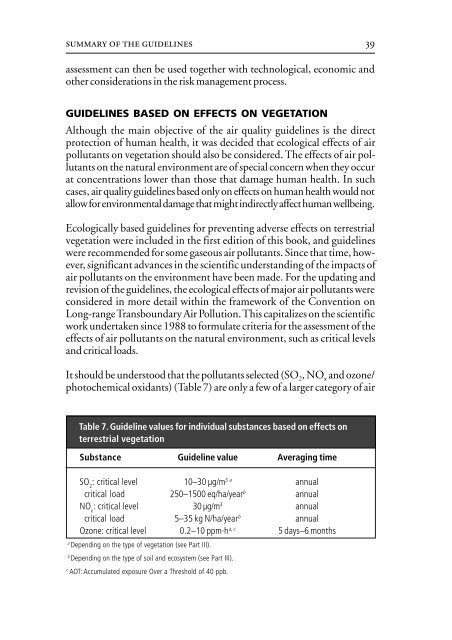Air Quality Guidelines - World Health Organization Regional Office ...
Air Quality Guidelines - World Health Organization Regional Office ...
Air Quality Guidelines - World Health Organization Regional Office ...
You also want an ePaper? Increase the reach of your titles
YUMPU automatically turns print PDFs into web optimized ePapers that Google loves.
summary of the guidelines<br />
assessment can then be used together with technological, economic and<br />
other considerations in the risk management process.<br />
GUIDELINES BASED ON EFFECTS ON VEGETATION<br />
Although the main objective of the air quality guidelines is the direct<br />
protection of human health, it was decided that ecological effects of air<br />
pollutants on vegetation should also be considered. The effects of air pollutants<br />
on the natural environment are of special concern when they occur<br />
at concentrations lower than those that damage human health. In such<br />
cases, air quality guidelines based only on effects on human health would not<br />
allow for environmental damage that might indirectly affect human wellbeing.<br />
Ecologically based guidelines for preventing adverse effects on terrestrial<br />
vegetation were included in the first edition of this book, and guidelines<br />
were recommended for some gaseous air pollutants. Since that time, however,<br />
significant advances in the scientific understanding of the impacts of<br />
air pollutants on the environment have been made. For the updating and<br />
revision of the guidelines, the ecological effects of major air pollutants were<br />
considered in more detail within the framework of the Convention on<br />
Long-range Transboundary <strong>Air</strong> Pollution. This capitalizes on the scientific<br />
work undertaken since 1988 to formulate criteria for the assessment of the<br />
effects of air pollutants on the natural environment, such as critical levels<br />
and critical loads.<br />
It should be understood that the pollutants selected (SO 2, NO x and ozone/<br />
photochemical oxidants) (Table 7) are only a few of a larger category of air<br />
Table 7. Guideline values for individual substances based on effects on<br />
terrestrial vegetation<br />
Substance Guideline value Averaging time<br />
SO 2 : critical level 10–30 µg/m 3 a annual<br />
critical load 250–1500 eq/ha/year b annual<br />
NO x : critical level 30 µg/m 3 annual<br />
critical load 5–35 kg N/ha/year b annual<br />
Ozone: critical level 0.2–10 ppm·h a, c 5 days–6 months<br />
a Depending on the type of vegetation (see Part III).<br />
b Depending on the type of soil and ecosystem (see Part III).<br />
c AOT: Accumulated exposure Over a Threshold of 40 ppb.<br />
39

















